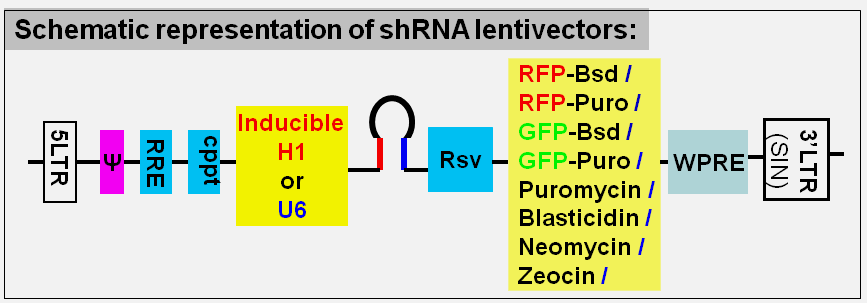shRNA Lentivectors
About RNA Interference:
RNA interference (RNAi) technology is a tool for performing loss-of-function (knockdown/silencing) studies in mammalian cells without making knock-out germ line cells. Originally, double-stranded short RNAs were found to inhibit gene expression in vivo through a series of enzymatic reactions mediated by short RNAs with sequences complementary to the silenced targets, leading to mRNA degradation or translational repression.
How to achieve RNAi:
RNAi knockdown can be introduced by synthetic short double-strand RNA (siRNA) or vector-expressed stem-hairpin RNA (shRNA) which is further processed by the Dicer enzyme to produce double-stranded short RNAs.
Chemically synthesized double-stranded RNA (siRNA) produces only a transient silencing effect; in contrast, vector-expressed shRNA can provide long term silencing.
Another category of RNAi known as micro-RNA (miRNA) utilizes a similar in vivo knockdown mechanism. Native or artificial miRNA can be processed from vector-expressed pre-micro RNA.
shRNA knockdown lentivector cloning kits:
GenTarget provides easy-to-use, unique, advanced cloning kits for constructing shRNA lentivectors using either the human U6 promoter or the human H1 promoter. The modified H1 promoter is an optional inducible promoter, which can be used for tetracycline-induced expression when needed.
You can select shRNA vectors with different antibiotic selection markers or fluorescent-antibiotic fusion dual markers. See lentiviral shRNA vector scheme below.

About promoter selection:
U6 and H1 are poly III promoters, best suited for the transcription of short RNA molecules. Both are active in the majority of mammalian cells, but one could be stronger than the other in a particular cell type. Unless you already know which promoter is better in your specific cell type, you can select either promoter for shRNA expression.
About shRNA lentivector:
The shRNA lentivector can be used directly in transfection for transient knockdown or to produce lentivirus for long-term knockdown experiments. Our lentiviral shRNA vectors have been validated to produce high titer lentivirus. Lentivirus packaging cells and packaging plasmids are required for shRNA lentivirus production; they are not included in this kit, but can be purchased separately.
Advantages of GenTarget’s Lentiviral shRNA:
- The shRNA lentivirus can be transduced into dividing and non-dividing cells and into the majority of mammalian cell types. The shRNA lentivirus integrates into the host cell genome for long-term knockdown
- The human H1 and U6 promoters are active in almost all types of mammalian cells. The lentivirus can be used for constitutive high shRNA expression, or optionally for tetracycline-inducible shRNA expression with the H1 promoter
- Many options for antibiotic selection: select from puromycin, blasticidin, Neomycin, Zeocin, or Dual markers as: GFP-puromycin, GFP-blasticidin, RFP-puromycin, and RFP-blasticidin
Please see the Product Manual for details.
And you can find all shRNA lentivector sequence here.
We also can do the shRNA cloning and virus works for you, providing shRNA lentivector cloning services with the fastest turnaround time and the best prices.
Citations:
-
Joyce Chen (et al), J Clin Invest. 2012;122(9):3184-3196. Chemokine 25-induced signaling suppresses colon cancer invasion and metastasis.